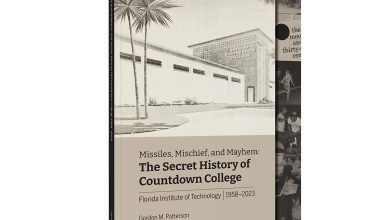Cinematic Science: Interstellar, Black Holes & Wormholes
“We are still pioneers . . . we’ve barely begun . . . our greatest accomplishments cannot be behind us, because our destiny lies above us.” –Cooper in Interstellar
Caltech’s theoretical astrophysicist Kip Thorne contributed to the script for last fall’s thought-provoking Interstellar and was a consultant for the design of the black hole and wormhole in the film. Some critics reviewing the film have pointed out the symbiotic relationship between science and the humanities. An examination of Thorne’s participation in the development of the script and the design of many of the visuals reveals the ways in which science and film have influenced each other considerably in the creation of this stunning cinematic experience.
#CinematicScience — The Science of Interstellar – WIRED http://t.co/UsHI6JxsL6 via @wired
— Debbie Lelekis (@DrLelekis) July 27, 2015
“Neither wormholes nor black holes have been depicted in any Hollywood movie in the way that they actually would appear.” Until Interstellar….
Even though wormholes have not been directly inspected by scientists and our knowledge of them is theoretical, Thorne was able to use the fictional space of film to, as David A. Kirby describes, “develop, visualize, and experiment with his conceptual models” in order to help create something visually interesting for the audience that would be scientifically based on the concepts of traversable wormholes. Director Christopher Nolan refers to Thorne as a “narrative collaborator” in Thorne’s book The Science of Interstellar, which can be read as a companion to the film. This description of Thorne’s role highlights his mission to, as he has put it, “weave real science into the film’s fabric.”
Thorne’s involvement meant that the film would need to follow some basic guidelines, which included a plot that was firmly situated within the laws of physics and a promise that narrative speculations about aspects of the universe that we don’t have firm knowledge of would spring from real science and ideas that actual scientists would regard as possible.
Gravity, Black Holes & Wormholes
In the dystopian future of the film, Cooper (Matthew McConaughey) and a small team of scientists try to get to a distant star system to find a new home for human life. To get there, they must travel through a wormhole. Thorne succinctly describes a wormhole as a shortcut from one place in the universe to another. We can only make educated guesses about what a traversable wormhole would look like and if they are even possible. The wormhole in Interstellar was created by an advanced civilization.
The film’s spinning black hole Gargantua, is also a key element of the narrative. While working on the visuals for it, Thorne used Einstein’s relativistic laws of physics and built upon prior work by other scientists to come up with the necessary equations to compute the trajectories of light rays that travel through Gargantua’s warped space and time. His equations were then converted into computer code which was used to create the amazing high-quality images needed for the film. As Adam Rogers describes in his Wired article “Wrinkles in Spacetime: The Warped Astrophysics of Interstellar,” “Thorne sees truth. Nolan, the consummate image maker, sees beauty. Black holes, even fictional ones, can warp perception.”
Similarly, Thorne worked on complex equations for the design of the wormhole, which Paul Franklin’s effects team, Double Negative, then used to create images by means of newly created rendering software. The relationship between science and film is a reciprocal one. According to Rogers, “In the end, Nolan got elegant images that advance the story. Thorne got a movie that teaches a mass audience some real, accurate science. But he also got something he didn’t expect: a scientific discovery.” Thorne has said, “For me, those film clips are like experimental data: they reveal things I never could have figured out on my own, without those simulations,” and he plans to publish technical papers on his new findings.
Scientist in Hollywood
Clearly films do have the potential to influence people’s perceptions of science in meaningful ways. Kip Thorne’s brilliance and tenacity contributed to the depiction of science on screen that is not only entertaining but also inspiring. His enthusiasm for conveying this science to the general public spills over into his book The Science of Interstellar and interviews he has done on the topic.
If you were intrigued by the science displayed in the film, you will find his book fascinating and while it is a challenging read, it is an enjoyable one too. Additionally, if you want the perspective of another great astrophysicist, Neil deGrasse Tyson, check out this video of his reactions to the film.
Stay tuned for the next installment of my Cinematic Science series when I look back at 1997’s Gattaca.





